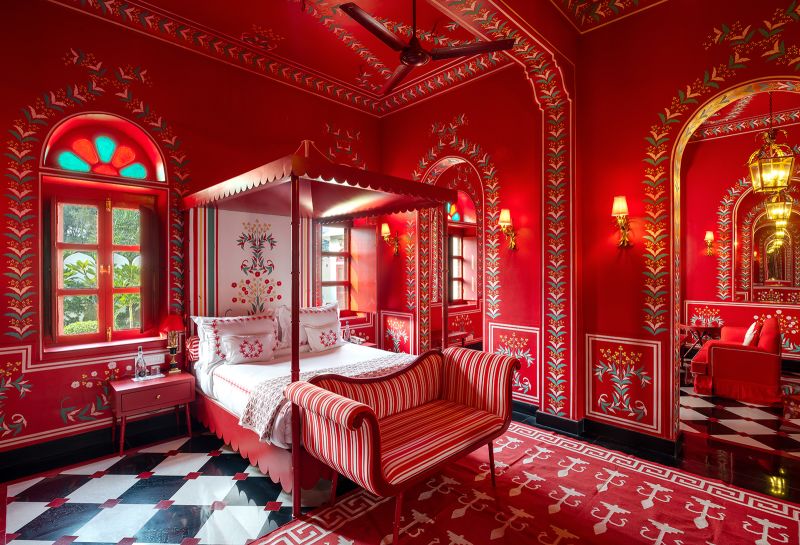Kanota, Rajasthan, is a dusty obscure hamlet these days.
But it once bridged India’s two ancient kingdoms: the Mughal court in Agra and the Royal court of Jaipur. On this road lies the Villa Palladio boutique hotel and resort.
A colorful history
Jaipur is known as “the pink city” for its pastel buildings. The Villa is half an hour away, but it feels like its own world.
For one thing, it’s not pink. It’s also not decked out in the floral or geometric patterns Jaipur is known for.
Instead, the structure has walls in a shade of scarlet borrowed from the Roman Catholic cardinals, pomegranates inspired by the paintings of Botticelli and palm trees, a symbol of Roman status.
The Villa was once a residence of the royal family of Kanota and was converted into a boutique hotel by Italian entrepreneur Barbara Miolini and Dutch designer Marie Anne Oudejans.
Both are now Jaipur residents.
Miolini grew up in Switzerland, came to Jaipur in 2005 on what was supposed to be a sabbatical, and ended up staying for good.
She spent the early years of her career in the Venetian countryside, influenced by historical and architectural references of one of the greatest Italian architects of the 16th century, Andrea Palladio.
Palladio was known for combining the elements of Renaissance and contemporary French practices, creating an altogether unique style known as Anglo-Palladianism.
Miolini wanted to create something similar, blending the Indo-Mughal and Italian Rococo styles to create something unique.
“The Jaipur court has been the center of Indian luxury production for nearly 300 years, while Venice was the capital of European luxury for centuries,” Miolini says. “There is incredible sophistication and presence of history in the aesthetics of both cities, and when conversing, they speak together beautifully.”
Winning over the locals
The building that became Villa Palladio has a brief but fantastic story.
It was built by the Kanota nobleman Abhay Singh in 1960 in a Rajasthani heritage style, with open pavilions, scalloped arches, courtyards, turrets, and fort-like walls.
Miolini says that the structure was in good shape and had been well cared for. “This place had a sense of Italian nostalgia for how one would encounter abandoned homes and castles on once-historical routes. I wanted to keep the structural interventions to a minimum.”
Marie Ann Oudejans, the Jaipur-based Dutch designer who collaborated with Miolini, adds: “The countryside has given me visual inspiration: the women in the fields, the royal princesses in their finery and veils. I mixed it with the exuberance of Italian flair.”
From there, the Villa started taking a shape.
The castellated watch towers were converted into guest rooms, painted in candy stripes. Italian sun umbrellas and spindly loungers were installed around a Mughal-style swimming pool.
The hard work and attention to detail paid off in a place that can sometimes be unwelcoming to new designs.
“Jaipur has its own distinct style,” Dr. Vibhor Mukul Singh, who has done architectural projects in both Italy and Rajasthan, says. “It is indeed challenging to get an acceptance for some foreign architecture here. The key is that Villa Palladio is Italian on the face and at the same time deeply rooted in the land.”
One way of staying true to the Villa’s heritage was by involving local craftspeople as much as possible. Miolini explains that the hotel’s comforters, cushions, rugs, lamps and chairs were all made in Jaipur.
In many cases, the local artisans had never been to Italy and didn’t know its traditions, but they followed Oudejans’ handmade sketches to create everything.
That didn’t come as a surprise to the designers.
“In our projects, we have realized that simple craftspeople have best understood our design and sensibility,” says Miolini.
The end result is a place where two countries cooperate rather than collide.
Villa Palladio, Abhay Niwas Palace Sumel, Jamdoli Chouraha, Rajasthan 302031, India; +91 141 296 9762






